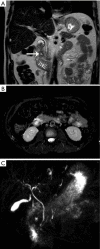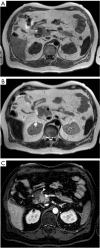Groove pancreatitis: a challenging imaging diagnosis
- PMID: 31559185
- PMCID: PMC6755950
- DOI: 10.21037/gs.2019.04.06
Groove pancreatitis: a challenging imaging diagnosis
Abstract
Groove pancreatitis (GP) is an uncommon form of chronic pancreatitis (CP) involving the space between duodenum, pancreatic head and common bile duct (CBD) known as pancreatic-duodenal groove. Although an association with long-standing ethanol assumption is reported a definite etiology of GP is unknown. Since thickening of the duodenal wall, pancreatic head enlargement, CBD stricture and dilatation of pancreatic duct system are common findings the differential diagnosis with pancreatic head neoplasm by means of imaging can be challenging. However, some imaging findings such as fibrotic changes of the pancreatic groove and presence of duodenal wall cysts may suggest the correct diagnosis. In this paper we review clinical and imaging features of GP with emphasis on computed tomography (CT) and magnetic resonance imaging (MRI) findings.
Keywords: Groove pancreatitis (GP); computed tomography (CT); magnetic resonance cholangiopancreatography (MRCP); magnetic resonance imaging (MRI).
Conflict of interest statement
Conflicts of Interest: The authors have no conflicts of interest to declare.
Figures






References
-
- Becker V. Bauchspeicheldrüse. In: Doerr W, Seifert G, Uhlinger E. editors. Spezielle pathologische Anatomie. Vol 4. Berlin: Springer, 1973:252-445.
-
- Stolte M, Weiss W, Volkholz H, et al. A special form of segmental pancreatitis: groove pancreatitis. Hepatogastroenterology 1982;29:198-208. - PubMed
-
- Becker V, Mischke U. Groove pancreatitis. Int J Pancreatol 1991;10:173-82. - PubMed
Publication types
LinkOut - more resources
Full Text Sources
Miscellaneous
